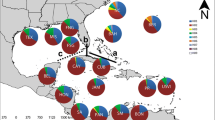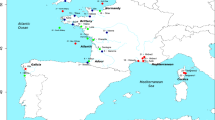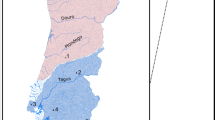Abstract
Invasive species are one of the greatest threats to global biodiversity and ecosystem health, and population genetics provides promising tools for understanding the evolutionary process of successful invaders. The well-documented introduction of the red lionfish (Pterois volitans) to the western Atlantic, Gulf of Mexico and Caribbean has decimated native fauna due to the invader’s voracious predation and growth rate. We tested whether our samples were within the region of the source of invasion into the Atlantic and Caribbean and investigated whether hybridization in the native or introduced range was responsible for the success of this invasive species. We used a reduced representation sequencing method to generate over 50,000 single nucleotide polymorphisms and sequence data from two mitochondrial DNA genes to analyze the population patterns. We found one location in the southeastern Pacific that was genetically similar to one location the southwestern Atlantic and evidence of the subsequent spread south to the Gulf of Mexico and the Caribbean, which supports previous findings. Within the native range, we found genetic divergences commensurate with distinct species and evidence of hybridization. We found limited structure within the introduced range and no evidence of Pterois miles or hybrids within this range. Finally, we found signatures of selection between the native and introduced range that may be a result of the introduction. Overall, this study of the red lionfish showed the pattern of introduction and suggested a deeper sampling of genomic data from individuals within the native range may reveal hybridization between species as the source of the aggressive invasion.



Similar content being viewed by others
Change history
08 May 2019
In the original publication of this article, Figs. 2 and 3 were published incorrectly.
References
Ahrenholz DW, Morris JA Jr (2010) Larval duration of the lionfish, Pterois volitans along the Bahamian Archipelago. Environ Biol Fish 88:305–309. https://doi.org/10.1007/s10641-010-9647-4
Albins MA (2015) Invasive Pacific lionfish Pterois volitans reduce abundance and species richness of native Bahamian coral-reef fishes. Mar Ecol Prog Ser 522:231–243. https://doi.org/10.3354/meps11159
Albins MA, Hixon MA (2008) Invasive Indo–Pacific lionfish Pterois volitans reduce recruitment of Atlantic coral-reef fishes. Mar Ecol Prog Ser 367:233–238. https://doi.org/10.3354/meps07620
Allendorf FW, Lundquist LL (2003) Introduction: population biology, evolution, and control of invasive species. Con Biol 17:24–30
Allendorf FW, Hohenlohe PA, Luikart G (2010) Genomics and the future of conservation genetics. Nat Rev Genet 11:697–709. https://doi.org/10.1038/nrg2844
Allendorf FW, Luikart G, Aitkin SN (2013) Conservation and the genetics of populations, 2nd edn. Blackwell, London
Antao T, Lopes A, Lopes RJ, Beja-Pereira A, Luikart G (2008) LOSITAN: a workbench to detect molecular adaptation based on a Fst -outlier method. BMC Bioinform 9:323. https://doi.org/10.1186/1471-2105-9-323
Beaumont MA, Nichols RA (1996) Evaluating loci for use in the genetic analysis of population structure. Proc R Soc Lond B Biol Sci 263:1619–1626. https://doi.org/10.1098/rspb.1996.0237
Benkwitt CE, Albins MA, Buch KL, Ingeman KE, Kindinger TL, Pusack TJ, Stallings CD, Hixon MA (2017) Is the lionfish invasion waning? Evidence from The Bahamas. Coral Reefs 36:1255–1261. https://doi.org/10.1007/s00338-017-1620-7
Bernardi G, Azzurro E, Golani D, Miller MR (2016) Genomic signatures of rapid adaptive evolution in the bluespotted cornetfish, a Mediterranean Lessepsian invader. Mol Ecol 25:3384–3396. https://doi.org/10.1111/mec.13682
Betancu-R R, Hines A, Acero AP, Orti G, Wilbur AE, Freshwater DW (2011) Reconstructiong the lionfish invasion: insights into Greater Caribbean biogeography. J Biogeogr 38:11281–11293. https://doi.org/10.1111/j.1365-2699.2011.02496.x
Bouzat J (2010) Conservation genetics of population bottlenecks: the role of chance, selection, and history. Conserv Genet 11:463–478. https://doi.org/10.1007/s10592-010-0049-0
Burford Reiskind MO, Coyle K, Daniels HV et al (2016) Development of a universal double-digest RAD sequencing approach for a group of nonmodel, ecologically and economically important insect and fish taxa. Mol Ecol Resour 16:1303–1314. https://doi.org/10.1111/1755-0998.12527
Burford Reiskind MO, Labadie P, Bargielowski I, Lounibos LP, Reiskind MH (2018) Rapid evolution and the genomic consequences of selection against interspecific mating. Mol Ecol. https://doi.org/10.1111/mec.14821
Butterfield JSS, Díaz-Ferguson E, Silliman BR et al (2015) Wide-ranging phylogeographic structure of invasive red lionfish in the Western Atlantic and Greater Caribbean. Mar Biol 162:773–781. https://doi.org/10.1007/s00227-015-2623-y
Catchen JM, Amores A, Hohenlohe P et al (2011) Stacks: building and genotyping Loci De Novo from short-read sequences. G3 Genes Genom Genet 1:171–182. https://doi.org/10.1534/g3.111.000240
Courtenay WR (1995) Marine fish introductions in southeastern Florida. Am Fish Soc Introd Fish Newsl 14:2–3. https://doi.org/10.3391/ai.2009.4.3.5
Cowen RK, Paris CB, Srinivasan A (2006) Scaling of connectivity in marine populations. Science 311:522–527. https://doi.org/10.1126/science.1122039
Cure K, McIlwain JL, Hixon MA (2014) Habitat plasticity in native Pacific red lionfish Pterois volitans facilitates successful invasion of the Atlantic. Mar Ecol Prog Ser 506:243–253. https://doi.org/10.3354/meps10789
Earl DA, Vonholdt BA (2012) Structure Harvester: a website and program for visualizing STRUCTURE output and implementing the Evanno method. Conserv Genet Resour 4:359–361. https://doi.org/10.1007/s12686-011-9548-7
Feng K, Luo H, Hou M, Li Y, Chen J, Zhu Z, Hu W (2018) Alternative splicing of GnRH2 and GnRH2-associated peptide plays roles in gonadal differentiation in the rice field eel, Monopterus albus. Gen Comp Endocrinol. https://doi.org/10.1016/j.ygcen.2018.05.021
Ferreira CEL, Luiz OJ, Floeter SR, Lucena MB, Barbosa MC, Rocha CR, Rocha LA (2015) First record of invasive lionfish (Pterois volitans) for the Brazilian coast. PLoS ONE 10:1–5. https://doi.org/10.1371/journal.pone.0123002
Fitzpatrick BM, Shaffer HB (2007) Hybrid vigor between native and introduced salamanders raises new challenges for conservation. Proc Natl Acad Sci 104:15793–15798. https://doi.org/10.1073/pnas.0704791104
Frankham R (2005) Resolving the genetic paradox in invasive species. Heredity 94:385
Freshwater DW, Hines A, Parham S, Wilbur A, Sabaoun M, Woodhead J, Akins L, Purdy B, Whitfield PA, Paris CB (2009) Mitochondrial control region sequence analyses indicate dispersal from the US East Coast as the source of the invasive Indo-Pacific lionfish Pterois volitans in the Bahamas. Mar Biol 156:1213–1221. https://doi.org/10.1007/s00227-009-1163-8
Gaither MR, Bernal MA, Coleman RR, Bowen BW, Jones SA, Simison WB, Rocha LA (2015) Genomic signatures of geographic isolation and natural selection in coral reef fishes. Mol Ecol 24:1543–1557. https://doi.org/10.1111/mec.13129
Grosholz ED, Ruiz GM, Dean CA, Shirley KA, Maron JL, Connors PG (2000) The impacts of a nonindigenous marine predator in a California bay. Ecology 81:1206–1224. https://doi.org/10.1890/0012-9658(2000)081%5b1206:TIOANM%5d2.0.CO;2
Hamner RM, Freshwater DW, Whitfield PE (2007) Mitochondrial cytochrome b analysis reveals two invasive lionfish species with strong founder effects in the western Atlantic. J Fish Biol 71:214–222. https://doi.org/10.1111/j.1095-8649.2007.01575.x
Hubisz MJ, Falush D, Stephens M, Pritchard JK (2009) Inferring weak population structure with the assistance of sample group information. Mol Ecol Resour 9:1322–1332. https://doi.org/10.1111/j.1755-0998.2009.02591.x
Jombart T (2008) Adegenet: a R package for the multivariate analysis of genetic markers. Bioinformatics 24:1403–1405. https://doi.org/10.1093/bioinformatics/btn129
Jud ZR, Layman CA (2012) Site fidelity and movement patterns of invasive lionfish, Pterois spp., in a Florida estuary. J Exp Mar Biol Ecol 414–415:69–74. https://doi.org/10.1016/j.jembe.2012.01.015
Kearse M, Moir R, Wilson A et al (2012) Geneious Basic: an integrated and extendable desktop software platform for the organization and analysis of sequence data. Bioinformatics 28:1647–1649
Kocher TD, Thomas WK, Meyer A et al (1989) Dynamics of mitochondrial DNA evolution in animals: amplification and sequencing with conserved primers. Proc Natl Acad Sci 86:6196–6200. https://doi.org/10.1073/pnas.86.16.6196
Kochzius M, Soller R, Khalaf MA, Blohm D (2003) Molecular phylogeny of the lionfish genera Dendrochirus and Pterois (Scorpeanidae, Pteroinae) based on mitochondrial DNA sequences. Mol Phylogenetics Evol 28:396–403
Kolbe JJ, Glor RE, Schettino LR, Lara AC, Larson A, Losos JB (2004) Genetic variation increases during biological invasion by Cuban lizard. Nature 431:177–181
Kulbicki M, Beets J, Chabanet P, Cure K, Darling E, Floeter SR, Galzin R, Green A, Harmelin-Vivien M, Hixon M, Letourneur Y, de Loma TL, McClanahan T, McIlwain J, MouTham G, Myers R, O’Leary JK, Planes S, Vigliola L, Wantiez L (2012) Distributions of Indo–Pacific lionfishes Pterois spp. in their native ranges: implications for the Atlantic invasion. Mar Ecol Prog Ser 446:189–205. https://doi.org/10.3354/meps09442
Layman CA, Allgeier JE (2012) Characterizing trophic ecology of generalist consumers: a case study of the invasive lionfish in The Bahamas. Mar Ecol Prog Ser 448:131–141. https://doi.org/10.3354/meps09511
Lee CE (2002) Evolutionary genetics of invasive species. Trends Ecol Evol 17:386–391
Lischer HEL, Excoffier L (2012) PGDSpider: an automated data conversion tool for connecting population genetics and genomics programs. Bioinformatics 28:298–299. https://doi.org/10.1093/bioinformatics/btr642
Maximino C, Lima MG, Olivera KR et al (2011) Adenosine A1 but not A2, receptor blockade increases anxiety and arousal in zebrafish. Basic Clin Pharmacol Toxicol 109:203–207
Meyer A, Kocher TD, Basasibwaki P, Wilson AC (1990) Monophyletic origin of Lake Victoria cichlid fishes suggested by mitochondrial DNA sequences. Nature 347:550–553
Meyer A, Morrissey JM, Schartl M (1994) Recurrent origin of a sexually selected trait in Xiphophorus fishes inferred from a molecular phylogeny. Nature 368:539–542
Morris JA, Akins JL (2009) Feeding ecology of invasive lionfish (Pterois volitans) in the Bahamian archipelago. Environ Biol Fish 86:389. https://doi.org/10.1007/s10641-009-9538-8
Muhlfeld CC, Kalinowski ST, McMahon TE, Taper ML et al (2009) Hybridization rapidly reduces fitness of a native trout in the wild. Biol Lett 5:328–331
Murray TF, Siebenaller JF (1987) Comparison of the binding properties of A1 adenosine receptors in brain membranes of two congeneric marine fishes living at different depths. J Comp Physiol B Biochem Syst Environ Physiol 157:267–277. https://doi.org/10.1007/BF00693353
Nishiguchi R, Azuma M, Yokobori E et al (2012) Gonadotropin-releasing hormone 2 suppresses food intake in the zerbrafish, Danio rerio. Front Endocrinol 3:1–6
Nolte AW, Freyhof J, Stemshorn KC, Tautz D (2005) An invasive lineage of sculpins, Cottus sp. (Pisces, Teleostei) in the Rhine with new habitat adaptations has originated from hybridization between old phylogeographic groups. Proc R Soc B 272:2379–2387
Palumbi SR (1996) Nucleic Acids II: the polymerase chain reaction. In: Hillis DM, Moritz C, Mable BK (eds) Molecular systematics, 2nd edn. Sinauer, Sunderland, pp 205–247
Pérez-Portela R, Buford A, Coffman B, Wedelich S, Davenport M, Fogg A, Swenarton MK, Coleman F, Johnston MA, Crawford DL, Oleksiak MF (2018) Genetic homogeneity of the invasive lionfish across the Northwestern Atlantic and the Gulf of Mexico based on single nucleotide polymorphisms. Sci Rep 8:5062. https://doi.org/10.1038/s41598-018-23339-w
Pritchard JK, Stephens M, Donnelly P (2000) Inference of population structure using multilocus genotype data. Genetics 155:945–959
Rousset F (2008) genepop’007: a complete re-implementation of the genepop software for Windows and Linux. Mol Ecol Resour 8:103–106. https://doi.org/10.1111/j.1471-8286.2007.01931.x
Schierenbeck KA, Ellstrand NC (2009) Hybridization and the evolution of invasiveness in plants and other organisms. Biol Invasions 11:1093–1105
Schofield PJ (2009) Geographic extent and chronology of the invasion of non-native lionfish (Pterois volitans [Linnaeus 1758] and P. miles [Bennett 1828]) in the Western North Atlantic and Caribbean Sea. Aquat Invasions 4:473–479. https://doi.org/10.3391/ai.2009.4.3.5
Selwyn JD, Johnson JE, Downey-Wall AM, Bynum AM, Hamner RM, Hogan JD, Bird CE (2017) Simulations indicate that scores of lionfish (Pterois volitans) colonized the Atlantic Ocean. PeerJ 5:e3996. https://doi.org/10.7717/peerj.3996
Shiganova TA (1998) Invasion of the Black Sea by the Ctenophore Mnemiopsis leidyi and recent changes in pelagic community structure. Fish Oceanogr 7:305–310. https://doi.org/10.1046/j.1365-2419.1998.00080.x
Toledo-Hernandez C (2014) Population ecology and genetics of the invasive lionfish in Puerto Rico. Aquat Invasions 9:227–237. https://doi.org/10.3391/ai.2014.9.2.12
Wakisaka N, Miyasaka N, Koide T et al (2017) An adenosine receptor for olfaction in fish. Curr Biol 27:1437–1447.e4. https://doi.org/10.1016/j.cub.2017.04.014
Walker BH, Steffen W (1997) An overview of the implications of global change for natural and mangaged terrestrial ecosystems. Conserv Ecol 2(2). http://www.consecol.org/vol1/iss2/art2
Whitfield PE, Gardner T, Vives SP, Gilligan MR, Courtenay WR Jr, Ray GC, Hare JA (2002) Biological invasion of the Indo-Pacific lionfish Pterois volitans along the Atlantic coast of North America. Mar Ecol Prog Ser 235:289–297. https://doi.org/10.3354/meps235289
Wilcox CL, Motomura H, Matsunuma M, Bowen BW (2017) Phylogeography of lionfishes (Pterois) indicate taxonomic over splitting and hybrid origin of the invasive Pterois volitans. J Hered 109:162–175. https://doi.org/10.1093/jhered/esx056
Acknowledgements
We thank M.R. Reiskind and R.R. Dunn for comments on an early version of this manuscript and several anonymous reviewers for their comments that improved this manuscript. The Wynne Innovation Grant from the CALS Dean’s Enrichment Grant program at NCSU awarded to MO Burford Reiskind funded this research. We also thank both the Applied Ecology and Entomology and Plant Pathology Departments at NCSU for providing matching funds to further fund this collaborative research. This study was a project in MO Burford Reiskind’s Conservation Genetics course at NCSU for undergraduate and graduate students.
Data Accessibility
We provided supplemental material with the original submission for the online version of this manuscript. This will include the results of the Genbank blast search for outlier loci. Data from this manuscript will be available through Dr. Martha Burford Reiskind’s DRYAD account. This will include post-STACK analysis input data files for PGDSpider from which subsequent input data files can be generated. The complete list of aligned sequences containing outlier loci. In addition, the raw sequence data generated in this study will be available upon request, as the data files far exceed the limits at DRYAD without addition payment.
Author information
Authors and Affiliations
Corresponding author
Additional information
Publisher's Note
Springer Nature remains neutral with regard to jurisdictional claims in published maps and institutional affiliations.
After first and second authors, author names were arranged in alphabetical order.
Electronic supplementary material
Below is the link to the electronic supplementary material.
Rights and permissions
About this article
Cite this article
Burford Reiskind, M.O., Reed, E.M.X., Elias, A. et al. The genomics of invasion: characterization of red lionfish (Pterois volitans) populations from the native and introduced ranges. Biol Invasions 21, 2471–2483 (2019). https://doi.org/10.1007/s10530-019-01992-0
Received:
Accepted:
Published:
Issue Date:
DOI: https://doi.org/10.1007/s10530-019-01992-0




